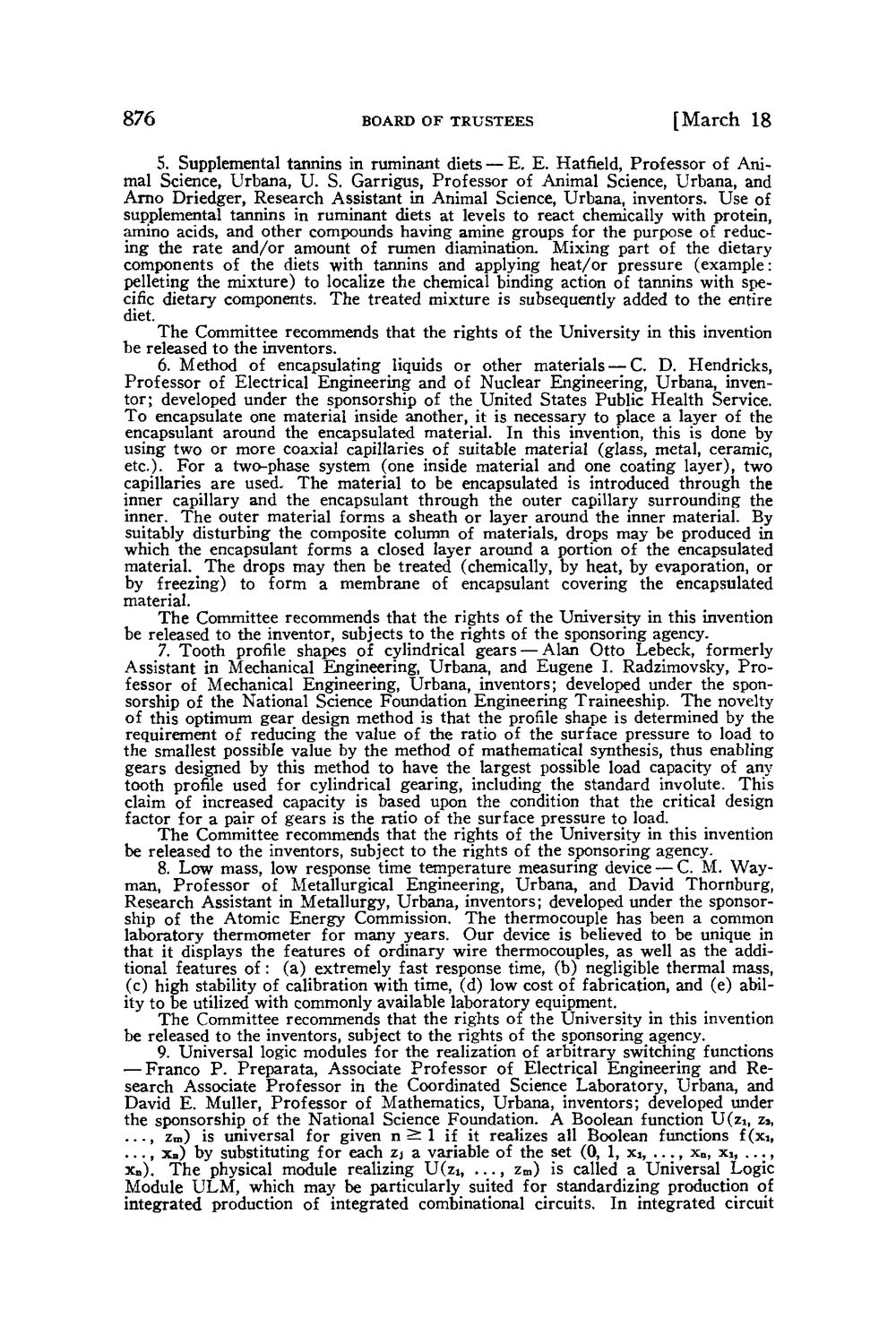| |
| |
Caption: Board of Trustees Minutes - 1970
This is a reduced-resolution page image for fast online browsing.

EXTRACTED TEXT FROM PAGE:
876 BOARD OF TRUSTEES [March 18 5. Supplemental tannins in ruminant diets — E. E. Hatfield, Professor of Animal Science, Urbana, U. S. Garrigus, Professor of Animal Science, Urbana, and Arno Driedger, Research Assistant in Animal Science, Urbana, inventors. Use of supplemental tannins in ruminant diets at levels to react chemically with protein, amino acids, and other compounds having amine groups for the purpose of reducing the rate and/or amount of rumen diamination. Mixing part of the dietary components of the diets with tannins and applying heat/or pressure (example: pelleting the mixture) to localize the chemical binding action of tannins with specific dietary components. The treated mixture is subsequently added to the entire diet. The Committee recommends that the rights of the University in this invention be released to the inventors. 6. Method of encapsulating liquids or other materials — C. D. Hendricks, Professor of Electrical Engineering and of Nuclear Engineering, Urbana, inventor; developed under the sponsorship of the United States Public Health Service. T o encapsulate one material inside another, it is necessary to place a layer of the encapsulant around the encapsulated material. In this invention, this is done by using two or more coaxial capillaries of suitable material (glass, metal, ceramic, etc.). For a two-phase system (one inside material and one coating layer), two capillaries are used. The material to be encapsulated is introduced through the inner capillary and the encapsulant through the outer capillary surrounding the inner. The outer material forms a sheath or layer around the inner material. By suitably disturbing the composite column of materials, drops may be produced in which the encapsulant forms a closed layer around a portion of the encapsulated material. The drops may then be treated (chemically, by heat, by evaporation, or by freezing) to form a membrane of encapsulant covering the encapsulated material. T h e Committee recommends that the rights of the University in this invention be released to the inventor, subjects to the rights of the sponsoring agency. 7. Tooth profile shapes of cylindrical gears — Alan Otto Lebeck, formerly Assistant in Mechanical Engineering, Urbana, and Eugene I. Radzimovsky, P r o fessor of Mechanical Engineering, Urbana, inventors; developed under the sponsorship of the National Science Foundation Engineering Traineeship. The novelty of this optimum gear design method is that the profile shape is determined by the requirement of reducing the value of the ratio of the surface pressure to load to the smallest possible value by the method of mathematical synthesis, thus enabling gears designed by this method to have the largest possible load capacity of any tooth profile used for cylindrical gearing, including the standard involute. This claim of increased capacity is based upon the condition that the critical design factor for a pair of gears is the ratio of the surface pressure to load. T h e Committee recommends that the rights of the University in this invention be released to the inventors, subject to the rights of the sponsoring agency. 8. Low mass, low response time temperature measuring device — C. M. Wayman, Professor of Metallurgical Engineering, Urbana, and David Thornburg, Research Assistant in Metallurgy, Urbana, inventors; developed under the sponsorship of the Atomic Energy Commission. T h e thermocouple has been a common laboratory thermometer for many years. Our device is believed to be unique in that it displays the features of ordinary wire thermocouples, as well as the additional features of: (a) extremely fast response time, (b) negligible thermal mass, (c) high stability of calibration with time, (d) low cost of fabrication, and (e) ability to be utilized with commonly available laboratory equipment. T h e Committee recommends that the rights of the University in this invention be released to the inventors, subject to the rights of the sponsoring agency. 9. Universal logic modules for the realization of arbitrary switching functions — Franco P . Preparata, Associate Professor of Electrical Engineering and Research Associate Professor in the Coordinated Science Laboratory, Urbana, and David E. Muller, Professor of Mathematics, Urbana, inventors; developed under the sponsorship of the National Science Foundation. A Boolean function U(zi, zi, . . - , Zm) is universal for given n i l if it realizes all Boolean functions f(xi, . . . , x . ) by substituting for each zj a variable of the set (0, 1, xi, . . . , x„, xi, . . . , x«). T h e physical module realizing U(zi, . . . , z m ) is called a Universal Logic Module U L M , which may be particularly suited for standardizing production of integrated production of integrated combinational circuits. In integrated circuit
| |